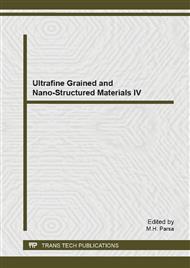[1]
F. Gaucherand, E. Beaugnon, Magnetic texturing in ferromagnetic cobalt alloys, Physica B. 346/347 (2204) 262-266.
DOI: 10.1016/j.physb.2004.01.062
Google Scholar
[2]
H.X. Li, X.F. Chen, Selective hydrogenation of Cinnanaldehyde to Cinnamyl Alcohol over an ultrafine Co- B amorphous alloy catalysts, Appl Catal A: Gen. 225 (2002) 117- 130.
DOI: 10.1016/s0926-860x(01)00855-9
Google Scholar
[3]
Y.D. Wang, X.P. Qi, Electrochemical hydrogen storage behaviors of ultrafine amorphous Co- B alloy particles, Chem. Mater. 16 (2004) 5194- 5197.
DOI: 10.1021/cm049252f
Google Scholar
[4]
Z.Z. Yuan, D.P. Zhang, Preparation and magnetic properties of amorphous Co-Cu-B alloy nano- powders, Intermetallics. 17 (2009) 281- 284.
DOI: 10.1016/j.intermet.2008.07.015
Google Scholar
[5]
Z.Z. Yuan, J.M. Chen, Y. Lu, X.P. Chen, Preparation and magnetic properties of amorphous Co-Zr-B alloy nano- powders, J. Alloys Compd. 450 (2008) 245-251.
DOI: 10.1016/j.jallcom.2006.10.099
Google Scholar
[6]
B.H. Liu, Z.P. Li, S. Suda, Nickel- and Cobalt- based catalysts for hydrogen generation by hydrolysis of borohydride, J. Alloys. Compd. 415 (2006) 288-293.
DOI: 10.1016/j.jallcom.2005.08.019
Google Scholar
[7]
B.D. Cullity, S.R. Stock, Elements of X- Ray Diffraction, 2th ed, Addison Wesley, (2001).
Google Scholar
[8]
H. Li, Y. Wu, H. Luo, M. Wang, Y. Xu, Liquid phase hydrogenation of acetonitrite to ethylamine over the Co- B amorphous alloy catalysts, J. Catal. 214 (2003) 15- 25.
Google Scholar
[9]
G.N. Glavee, K.J. Klabunde, C.M. Sorensen, G.C. Hadjipanayis, Sodium borohydride reduction of cobalt ions in nonaqueous media, Inorg. Chem. 32 (1993) 474- 477.
DOI: 10.1021/ic00056a022
Google Scholar
[10]
A.K. Srivastava, S. Madhavi, A novel method to synthesis Cobalt Oxide (Co3O4) nanowires from Cobalt (Co) nanobowls, Phys. Status. Solidi A. 207 (2010) 963- 966.
DOI: 10.1002/pssa.200925503
Google Scholar
[11]
Chong-Hu Wu, Low energy-consumption industrial production of ultra-fine spherical cobalt powders, Energy Conservation, InTech., New York , 2012, pp.155-167.
DOI: 10.5772/52113
Google Scholar
[12]
A. Pozio, M. De Francesco, Apparatus for the production of hydrogen from sodium borohydride in alkaline solution, Int.J. Hydrogen Energy. 33 (2008) 51-56.
DOI: 10.1016/j.ijhydene.2007.08.024
Google Scholar
[13]
J. Andrieux, D. Swierezynski, A multifactor study of catalyzed hydrolysis of solid NaBH4 on Cobalt nanoparticles: thermodynamic and kinetics, Int. J. Hydrogen Energy. 34 (2009) 938- 951.
DOI: 10.1016/j.ijhydene.2008.09.102
Google Scholar
[14]
T. Cosgrove, Colloid Science: Principles, Methods, and Applications, Blackwell Publishing, Bristol, (2005).
Google Scholar


